[ANSWERED] What is Third-Party Cyber Coverage?
In this blog post we discuss what third-party cyber coverage.

In 2022, the cost of cybercrime was $8.44 trillion globally. Experts estimate that cybercrime costs worldwide will exceed $20 trillion by 2026. This means that in four years, cybercrime will increase by almost 150%.
If you think this is expensive, you would be right. But many companies don’t have cyber risk insurance. Business owners who don’t have cyber coverage usually say that the price of such insurance is the main reason for not having it. But clearly, companies can’t afford not to have cyber coverage.
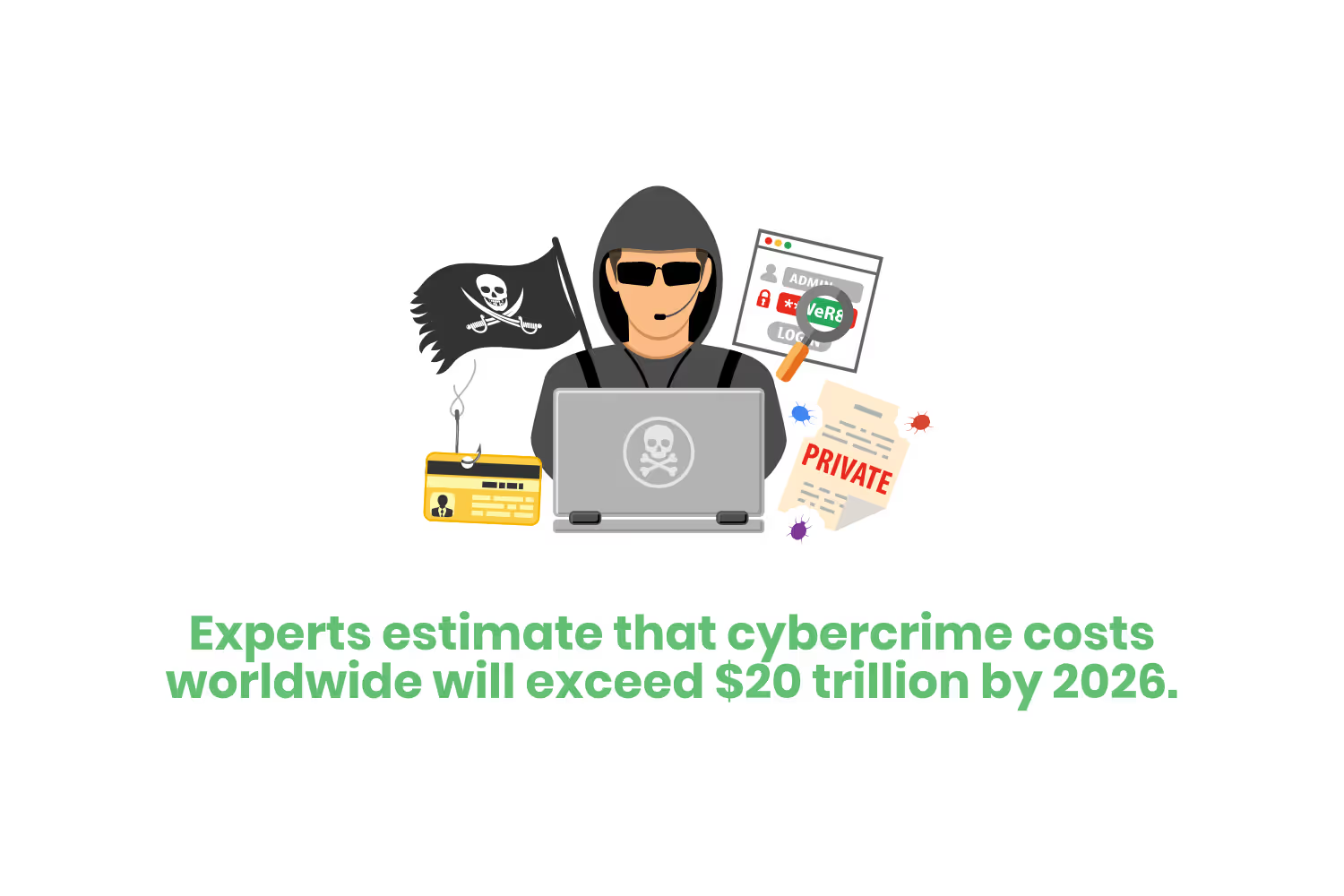
No matter how improbable you may think it is, cyberattacks and data breaches happen every day across the U.S. All forms of cyber coverage cover the risks associated with cyber-attacks.
You can’t afford not to protect your company, especially in a world where data exists everywhere.
But what is third-party cyber-coverage?
What is third-party cyber coverage?
Third-party cyber coverage provides liability coverage for businesses. Such businesses are responsible for a client’s online security. This includes protecting clients from data breaches and other forms of cyberattacks.
If a client experiences a cybersecurity breach and sues your company, third-party cyber liability insurance can help pay for your business’s expenses incurred from legal proceedings.
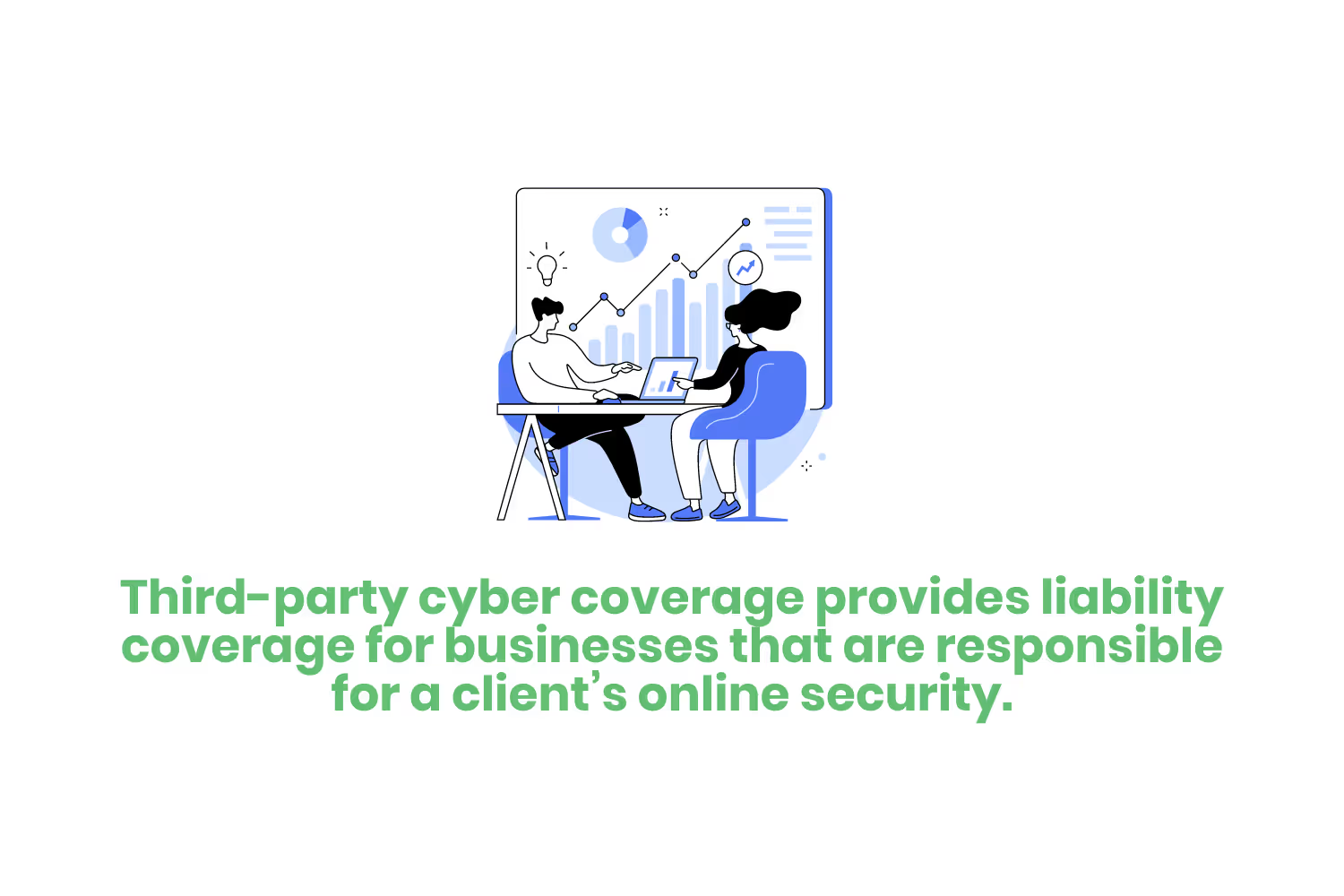
What types of businesses need third-party cyber coverage?
Many businesses in the information technology space may benefit from having third-party cyber insurance. For example, businesses that install or service computer networks fall under this category.
Other IT businesses that can benefit from third-party cyber insurance policies include…
- IT consultants
- Software developers
- App developers
- Web designers
- Web hosting businesses
- Network consultants
- Security consultants
Third-party cyber insurance is often included in an “errors and omissions” insurance policy for tech professionals.
This type of cybersecurity coverage helps pay for lawsuits when businesses face lawsuits concerning data breaches, another mistake, or some kind of oversight. Such a lawsuit is usually brought on by either a business’s actions or inactions.
First-Party Vs. Third-Party Cyber Coverage
Most IT businesses can benefit from third-party coverage. After all, it protects them from client lawsuits. However, any business that stores sensitive data online should consider getting first-party cyber coverage too.
First-Party Cyber Insurance
First-party cyber insurance addresses the financial difficulties following a cybersecurity breach on a business’s network.
For example, if an e-commerce website is the victim of a hack, and cybercriminals steal customer credit card numbers, first-party cyber coverage can pay for expenses.
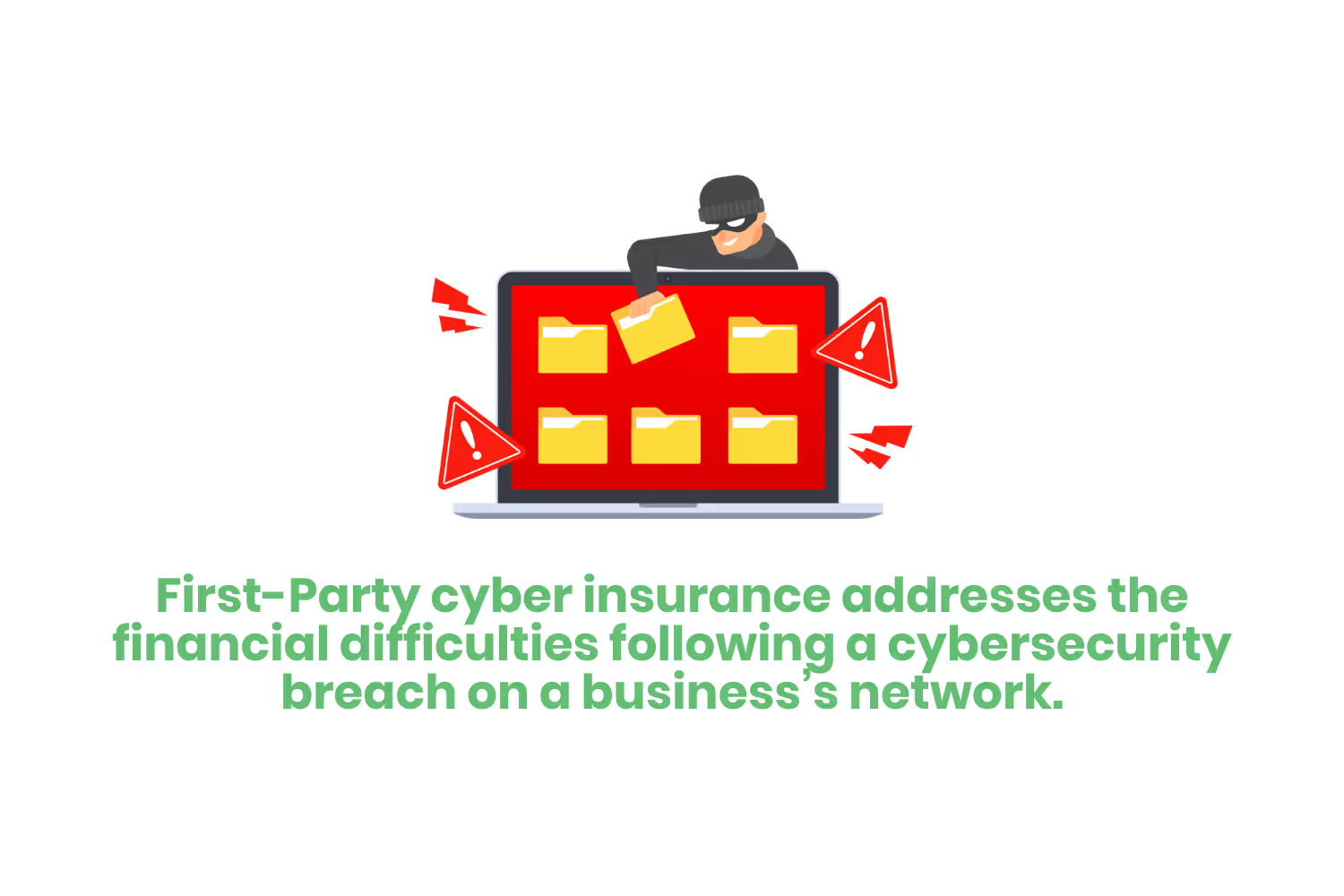
First-party cyber coverage will pay for expenses such as…
- Notifying impacted customers
- Credit monitoring
- Public relations campaign for damage control
This type of insurance can also pay for expenses related to cyber extortion.
For example, if a ransomware attack is holding a company’s data hostage, the provider’s insurance can pay the ransom to (hopefully) get the data restored.
Third-Party Cyber Insurance
In comparison, third-party cyber insurance covers expenses for businesses responsible for clients’ online security and data.
If an IT company’s client experiences a ransomware attack or data breach, they may sue the IT company. If that happens, the IT company’s third-party insurance can pay for the necessary legal expenses to defend the business in court.
Third-Party Cyber Coverage in Action
Let’s say someone hired you, an IT consultant, to help set up a security protocol at a client’s company. You recommend antivirus software that has few recent well-documented weaknesses.
When your client’s network gets hacked, cybercriminals steal the customers’ sensitive information. The client blames you and files a lawsuit.
At this point, your third-party cyber insurance can help pay for…
- Lawyers fees
- Settlements if you settle out of court
- Judgments if a judge finds you liable for the breach
- Other court costs
- Witness fees
- Docket fees
The Line Between First-Party & Third-Party Coverage
Although the main differences between first-party and third-party coverage seem cut and dry. The line seems to blur when it comes to damages within those two categories.
For example, sometimes breaches affect both the organization and its clients. Who’s at fault?
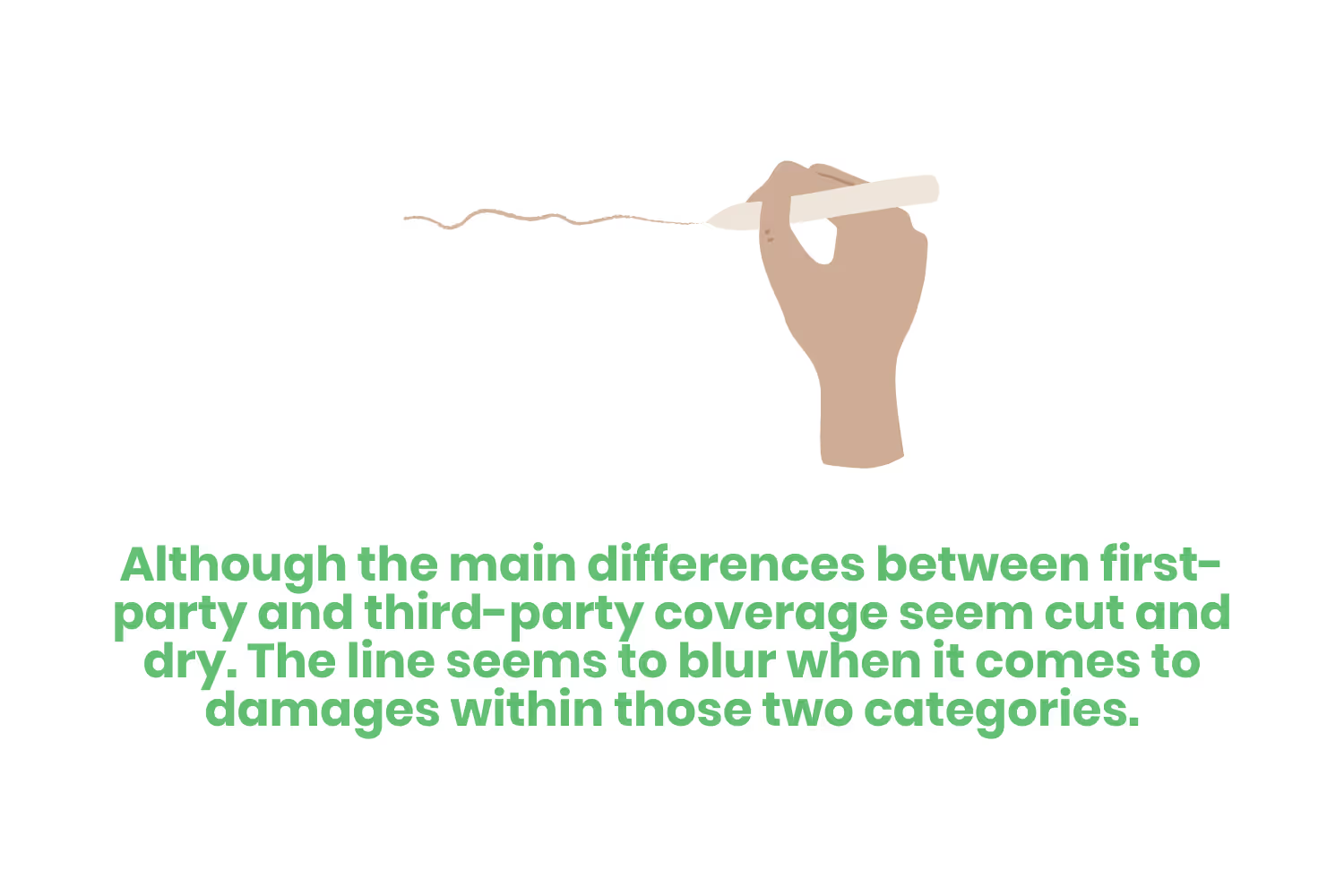
In scenarios such as this, forensic analysts have a lot of work ahead of them. If they cannot conclusively determine either sequence of events leading up to the breach and/or how the breach occurred, which is oftentimes the outcome in scenarios such as this…what do these damages fall under?
Spoiler alert for the next section. Since the line between first-party and third-party coverage isn’t always clearly defined, it’s often recommended that organizations have both categories of coverage.
What type of cybersecurity coverage do you need?
Now comes the fun part.
By reading this blog post, you likely already know that cyber coverage is an essential aspect of running a modern business. But, now that I’ve explained to you the two different types of cyber coverage that exist, which type do you choose?
In a perfect world, you should have both. Or, at least some of both. I know what you’re thinking, “That sounds expensive.”

Let me explain why you should have some coverage of both types.
The need for third-party cyber coverage is blatantly obvious for organizations that house their clients’ data. The best examples of those types of organizations are healthcare clearinghouses and managed service providers (MSPs).
Yet, the reality is that every type of organization should consider third-party coverage. The risk of inadvertently forwarding an email that contains malware is an ever-looming threat. After all, studies show that 83% of organizations have accidentally exposed sensitive data.
To pile on, hackers will oftentimes use the systems they’ve compromised as a launchpad for attacks on other organizations. In other words, if your system falls victim to a hacker…they’re likely going to use your accounts to infect additional third parties.
What's not covered?
Of course, there are exclusions associated with cyber coverage. We are talking about insurance, after all.
In general, cybersecurity insurance excludes instances where human error or negligence were present.
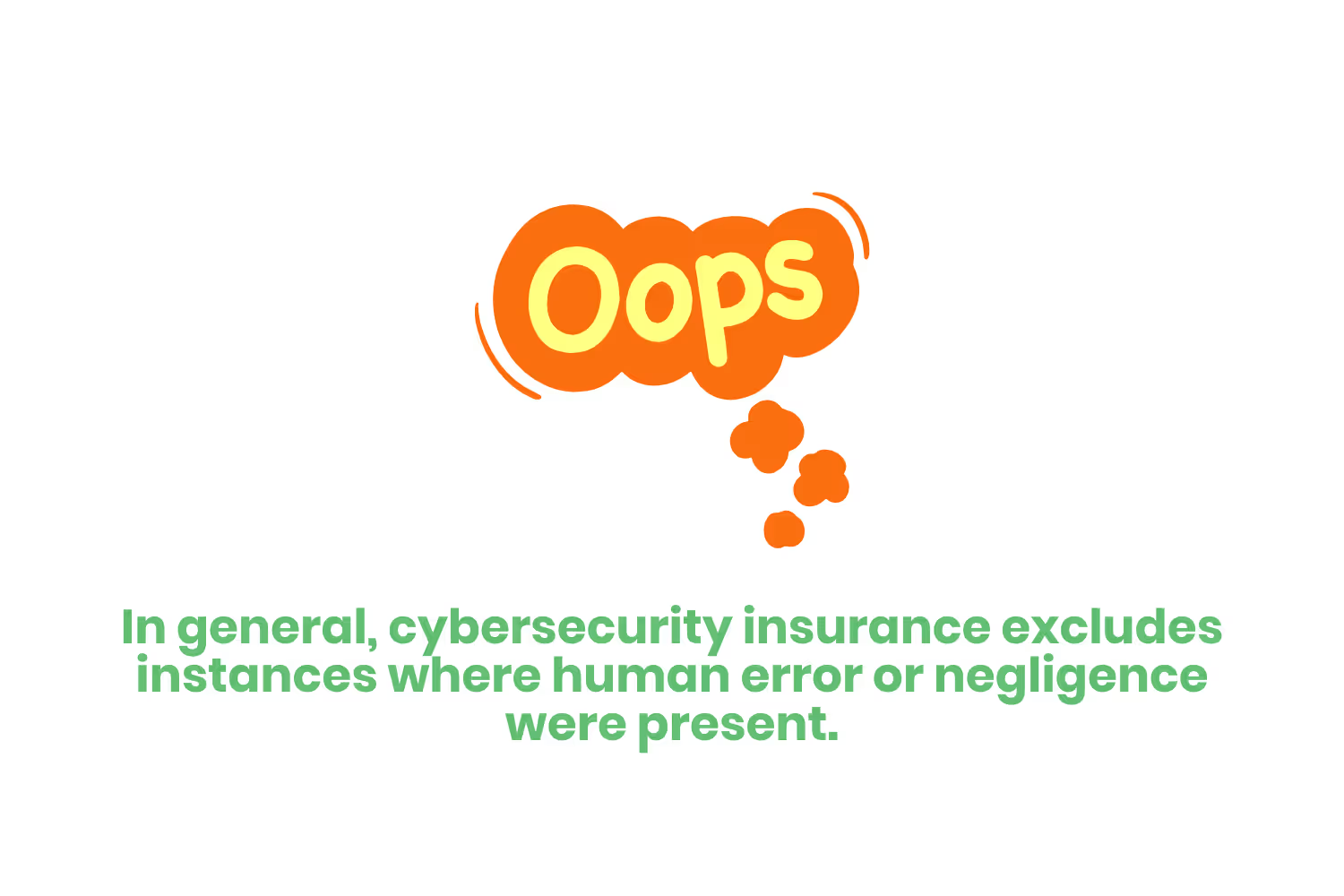
What does that mean? We need specifics.
Common exclusions include…
- Poor security processes
- Prior breaches
- Human error
- Insider attacks
- Pre-existing vulnerabilities
- Technology system improvements
Out of all of those exclusions, the most common that organizations run into is human error and poor security processes. Stanford found that 88% of data breach incidents occur due to human error. Meanwhile, nearly 50% of organizations don’t have adequate processes in place to detect and mitigate cyber threats.
Those statistics don’t instill much confidence. However, they’re important to know…especially when evaluating cybersecurity insurance providers and their exclusions.
Conclusion
Cyberattacks continue to rise. Ransomware, phishing attacks, and data breaches occur more often now than ever before. These impact more businesses each year.
If a hacker targets and attacks one of your clients, and your client then sues your business, the resulting legal bills could be devastating.
This is where third-party cyber coverage comes into play. It helps ensure that your IT business can survive the financial aftermath of cybercrime.
Emphasize your product's unique features or benefits to differentiate it from competitors
In nec dictum adipiscing pharetra enim etiam scelerisque dolor purus ipsum egestas cursus vulputate arcu egestas ut eu sed mollis consectetur mattis pharetra curabitur et maecenas in mattis fames consectetur ipsum quis risus mauris aliquam ornare nisl purus at ipsum nulla accumsan consectetur vestibulum suspendisse aliquam condimentum scelerisque lacinia pellentesque vestibulum condimentum turpis ligula pharetra dictum sapien facilisis sapien at sagittis et cursus congue.
- Pharetra curabitur et maecenas in mattis fames consectetur ipsum quis risus.
- Justo urna nisi auctor consequat consectetur dolor lectus blandit.
- Eget egestas volutpat lacinia vestibulum vitae mattis hendrerit.
- Ornare elit odio tellus orci bibendum dictum id sem congue enim amet diam.
Incorporate statistics or specific numbers to highlight the effectiveness or popularity of your offering
Convallis pellentesque ullamcorper sapien sed tristique fermentum proin amet quam tincidunt feugiat vitae neque quisque odio ut pellentesque ac mauris eget lectus. Pretium arcu turpis lacus sapien sit at eu sapien duis magna nunc nibh nam non ut nibh ultrices ultrices elementum egestas enim nisl sed cursus pellentesque sit dignissim enim euismod sit et convallis sed pelis viverra quam at nisl sit pharetra enim nisl nec vestibulum posuere in volutpat sed blandit neque risus.

Use time-sensitive language to encourage immediate action, such as "Limited Time Offer
Feugiat vitae neque quisque odio ut pellentesque ac mauris eget lectus. Pretium arcu turpis lacus sapien sit at eu sapien duis magna nunc nibh nam non ut nibh ultrices ultrices elementum egestas enim nisl sed cursus pellentesque sit dignissim enim euismod sit et convallis sed pelis viverra quam at nisl sit pharetra enim nisl nec vestibulum posuere in volutpat sed blandit neque risus.
- Pharetra curabitur et maecenas in mattis fames consectetur ipsum quis risus.
- Justo urna nisi auctor consequat consectetur dolor lectus blandit.
- Eget egestas volutpat lacinia vestibulum vitae mattis hendrerit.
- Ornare elit odio tellus orci bibendum dictum id sem congue enim amet diam.
Address customer pain points directly by showing how your product solves their problems
Feugiat vitae neque quisque odio ut pellentesque ac mauris eget lectus. Pretium arcu turpis lacus sapien sit at eu sapien duis magna nunc nibh nam non ut nibh ultrices ultrices elementum egestas enim nisl sed cursus pellentesque sit dignissim enim euismod sit et convallis sed pelis viverra quam at nisl sit pharetra enim nisl nec vestibulum posuere in volutpat sed blandit neque risus.
Vel etiam vel amet aenean eget in habitasse nunc duis tellus sem turpis risus aliquam ac volutpat tellus eu faucibus ullamcorper.
Tailor titles to your ideal customer segment using phrases like "Designed for Busy Professionals
Sed pretium id nibh id sit felis vitae volutpat volutpat adipiscing at sodales neque lectus mi phasellus commodo at elit suspendisse ornare faucibus lectus purus viverra in nec aliquet commodo et sed sed nisi tempor mi pellentesque arcu viverra pretium duis enim vulputate dignissim etiam ultrices vitae neque urna proin nibh diam turpis augue lacus.



![[ANSWERED] What to do if your email is on the dark web?](https://cdn.prod.website-files.com/67e2b8210878abcba6f91ae6/68adc0209238d61bc357cb8d_EmailonTheDarkWeb_1224.avif)
![[ANSWERED] What is Dark Web Monitoring?](https://cdn.prod.website-files.com/67e2b8210878abcba6f91ae6/68adbe4fe3e9533f2c658048_WhatisDarkWebMonitoring_1224.avif)